|
It was the crime of the century, and three quarters of a century later, the mere 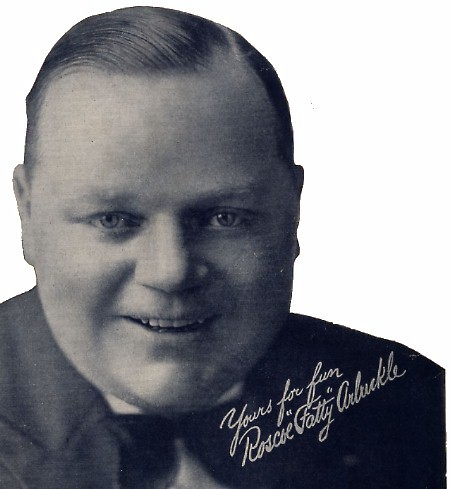 mention of it would continue to incite indignation, outrage, even revulsion. It would be Hollywood's first real scandal, and the newspapermen would blur the line between lurid fact and salacious fantasy. mention of it would continue to incite indignation, outrage, even revulsion. It would be Hollywood's first real scandal, and the newspapermen would blur the line between lurid fact and salacious fantasy.
You want true crime?
Mystery?
Lust?
Betrayal?
Corruption?
It's all here, pal.
And it all happened.
The tale of Roscoe "Fatty" Arbuckle, his Labor Day party, and his infamous guest Virginia Rappe has become the
stuff of legend. Today, the myths and lies are far more
well-known than the facts.
It is a sad tale of a very funny fellow.
Here's a little background . . .
Roscoe arrived in Hollywood at the perfect
moment in time; "the movies" had just re-
located to the West Coast, and a fellow
named Mack Sennett had the vision to
offer Roscoe, a 6' 2", 280 lb.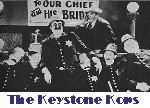 baby-faced
buffo, a contract as one of the Keystone
comedians. Roscoe served as a bit player
initially, even working as one of the famed
"Keystone Kops", until Sennett's mistress
(Mabel Normand) recognized the flair that
Roscoe showed for writing, directing and
what would later be called cinematography,
(in addition to being a wonderfully amusing
young man.) Mabel pushed for Mack to give
Roscoe his own production unit at the
Keystone baby-faced
buffo, a contract as one of the Keystone
comedians. Roscoe served as a bit player
initially, even working as one of the famed
"Keystone Kops", until Sennett's mistress
(Mabel Normand) recognized the flair that
Roscoe showed for writing, directing and
what would later be called cinematography,
(in addition to being a wonderfully amusing
young man.) Mabel pushed for Mack to give
Roscoe his own production unit at the
Keystone 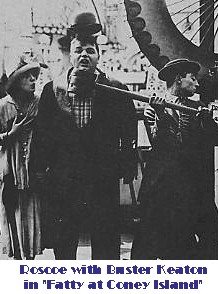 lot, and the rest is history. Roscoe
not only cranked out dozens of hilarious
two-reelers, but pioneered camera angles,
cinematic tricks, tracking shots and "pans"
that are still used today. lot, and the rest is history. Roscoe
not only cranked out dozens of hilarious
two-reelers, but pioneered camera angles,
cinematic tricks, tracking shots and "pans"
that are still used today.
He had the good fortune to be in the right
place at the right time.
But Sennett was a demanding overlord, and
Roscoe soon had other offers. Adolph Zukor
set Roscoe up with his own production
company, "Comique", under the auspices of
Paramount Pictures. And as his creative con-
trol grew, so did the box office revenues.
In 1921, Roscoe signed a $3 Million contract,
making him the second-highest paid comedian
in the world after his close friend Charlie
Chaplin. It seemed the world was Roscoe's
oyster. Adolph Zukor
set Roscoe up with his own production
company, "Comique", under the auspices of
Paramount Pictures. And as his creative con-
trol grew, so did the box office revenues.
In 1921, Roscoe signed a $3 Million contract,
making him the second-highest paid comedian
in the world after his close friend Charlie
Chaplin. It seemed the world was Roscoe's
oyster.
To celebrate his new contract, Roscoe decided
to throw a party at the St. Francis Hotel in
San 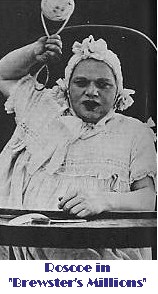 Francisco, where scrutiny of film actors
and adherence to prohibition-era liquor laws
were less intense than it was in Hollywood.
But this time, Roscoe was in the wrong place at
the wrong time. Francisco, where scrutiny of film actors
and adherence to prohibition-era liquor laws
were less intense than it was in Hollywood.
But this time, Roscoe was in the wrong place at
the wrong time.
A starlet named Virginia Rappe was in attendance
at the party, and she took ill during the
festivities. Although all credible records indicate
that Virginia's illness resulted from peritonitis,
and that Roscoe sought suitable medical attention
and accomodations for her, the story the public
heard would be significantly different when
Virginia died a few days later.
William Randolph Hearst, then the publisher of The
San Francisco Examiner, (as well as a dozen other
newspapers around the country,) recognized a story
that would sell newspapers when he saw it.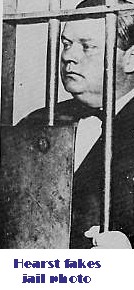 Hearst's
reporters began telling sensational tales about the case
that bore strikingly little resemblance to the facts.
These Hearst stories prompted Matthew Brady,
San Francisco's ambitious District Attorney,
to prosecute Arbuckle for murder. A sensational
murder trial, he thought, would help him in his
bid for the Governor's Mansion in Sacramento.
But the case was so weak, that it was almost immediately
reduced to manslaughter, and the presiding judge
had trepidations about even that. Hearst's
reporters began telling sensational tales about the case
that bore strikingly little resemblance to the facts.
These Hearst stories prompted Matthew Brady,
San Francisco's ambitious District Attorney,
to prosecute Arbuckle for murder. A sensational
murder trial, he thought, would help him in his
bid for the Governor's Mansion in Sacramento.
But the case was so weak, that it was almost immediately
reduced to manslaughter, and the presiding judge
had trepidations about even that.
"Roscoe," a new American musical (with music
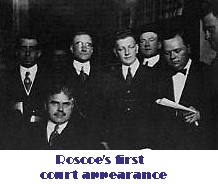 by Seth Evans and lyrics and libretto by Don
Stitt,) tells the story of the case of The People
of San Francisco vs. Roscoe C. Arbuckle.
It's a story of media hype, of greed and ambition,
of the power of love and friendship, and of what
would eventually be called The Court of Public
Opinion. by Seth Evans and lyrics and libretto by Don
Stitt,) tells the story of the case of The People
of San Francisco vs. Roscoe C. Arbuckle.
It's a story of media hype, of greed and ambition,
of the power of love and friendship, and of what
would eventually be called The Court of Public
Opinion.
In every sense of the phrase, the tale is a
comic tragedy.
Hollywood owes a great debt of gratitude to this
kind, generous, imaginitive giant.
"Roscoe", the musical, aims to tell the true story
of a creative giant undone by corruption, ambition,
politics and innuendo.
It's creators believe it is high time this icon of the
film world was restored to his rightful place in the
pantheon of Artistic Greatness.
|
 mention of it would continue to incite indignation, outrage, even revulsion. It would be Hollywood's first real scandal, and the newspapermen would blur the line between lurid fact and salacious fantasy.
mention of it would continue to incite indignation, outrage, even revulsion. It would be Hollywood's first real scandal, and the newspapermen would blur the line between lurid fact and salacious fantasy. baby-faced
buffo, a contract as one of the Keystone
comedians. Roscoe served as a bit player
initially, even working as one of the famed
"Keystone Kops", until Sennett's mistress
(Mabel Normand) recognized the flair that
Roscoe showed for writing, directing and
what would later be called cinematography,
(in addition to being a wonderfully amusing
young man.) Mabel pushed for Mack to give
Roscoe his own production unit at the
Keystone
baby-faced
buffo, a contract as one of the Keystone
comedians. Roscoe served as a bit player
initially, even working as one of the famed
"Keystone Kops", until Sennett's mistress
(Mabel Normand) recognized the flair that
Roscoe showed for writing, directing and
what would later be called cinematography,
(in addition to being a wonderfully amusing
young man.) Mabel pushed for Mack to give
Roscoe his own production unit at the
Keystone  lot, and the rest is history. Roscoe
not only cranked out dozens of hilarious
two-reelers, but pioneered camera angles,
cinematic tricks, tracking shots and "pans"
that are still used today.
lot, and the rest is history. Roscoe
not only cranked out dozens of hilarious
two-reelers, but pioneered camera angles,
cinematic tricks, tracking shots and "pans"
that are still used today.
 Adolph Zukor
set Roscoe up with his own production
company, "Comique", under the auspices of
Paramount Pictures. And as his creative con-
trol grew, so did the box office revenues.
In 1921, Roscoe signed a $3 Million contract,
making him the second-highest paid comedian
in the world after his close friend Charlie
Chaplin. It seemed the world was Roscoe's
oyster.
Adolph Zukor
set Roscoe up with his own production
company, "Comique", under the auspices of
Paramount Pictures. And as his creative con-
trol grew, so did the box office revenues.
In 1921, Roscoe signed a $3 Million contract,
making him the second-highest paid comedian
in the world after his close friend Charlie
Chaplin. It seemed the world was Roscoe's
oyster.
 Francisco, where scrutiny of film actors
and adherence to prohibition-era liquor laws
were less intense than it was in Hollywood.
But this time, Roscoe was in the wrong place at
the wrong time.
Francisco, where scrutiny of film actors
and adherence to prohibition-era liquor laws
were less intense than it was in Hollywood.
But this time, Roscoe was in the wrong place at
the wrong time.
 Hearst's
reporters began telling sensational tales about the case
that bore strikingly little resemblance to the facts.
These Hearst stories prompted Matthew Brady,
San Francisco's ambitious District Attorney,
to prosecute Arbuckle for murder. A sensational
murder trial, he thought, would help him in his
bid for the Governor's Mansion in Sacramento.
But the case was so weak, that it was almost immediately
reduced to manslaughter, and the presiding judge
had trepidations about even that.
Hearst's
reporters began telling sensational tales about the case
that bore strikingly little resemblance to the facts.
These Hearst stories prompted Matthew Brady,
San Francisco's ambitious District Attorney,
to prosecute Arbuckle for murder. A sensational
murder trial, he thought, would help him in his
bid for the Governor's Mansion in Sacramento.
But the case was so weak, that it was almost immediately
reduced to manslaughter, and the presiding judge
had trepidations about even that.
 by Seth Evans and lyrics and libretto by Don
Stitt,) tells the story of the case of The People
of San Francisco vs. Roscoe C. Arbuckle.
It's a story of media hype, of greed and ambition,
of the power of love and friendship, and of what
would eventually be called The Court of Public
Opinion.
by Seth Evans and lyrics and libretto by Don
Stitt,) tells the story of the case of The People
of San Francisco vs. Roscoe C. Arbuckle.
It's a story of media hype, of greed and ambition,
of the power of love and friendship, and of what
would eventually be called The Court of Public
Opinion.